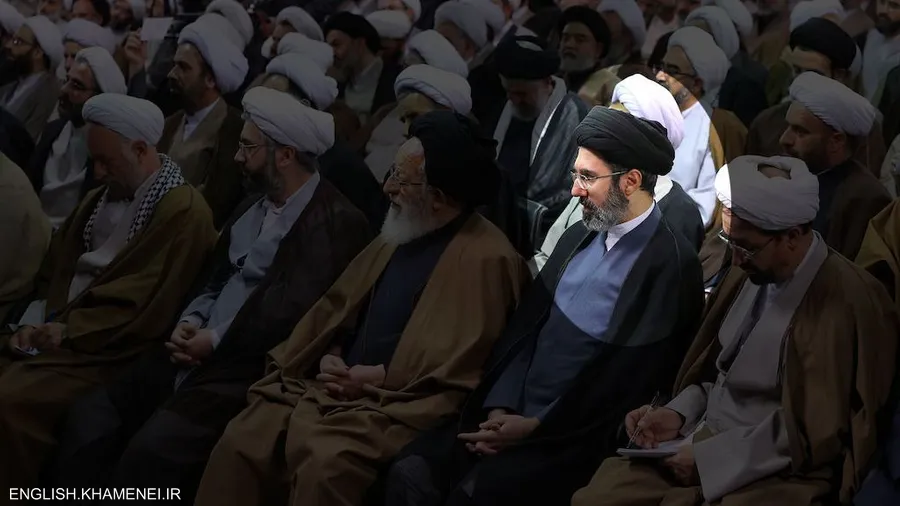Iran Succession Chatter Intensifies as Khamenei’s Son Emerges as Leading Contender by Mohammed Albasha

The unexpected death of Iranian President Ebrahim Raisi in a helicopter crash near the border with Azerbaijan has amplified longstanding speculation over who will eventually succeed the aging Supreme Leader Ali Khamenei at the pinnacle of Iran’s ruling hierarchy. As the murky circumstances around Raisi’s death fuel rumors of a regime power play, one name has crystallized as the clear frontrunner – Mojtaba Khamenei, the influential second son of the of the 83-year-old Supreme Leader’s six children.
For years, Mojtaba’s name has been persistently floated as a potential successor to his father, who has held Iran’s highest position of authority since 1989. However, the senior Khamenei and his loyalists have repeatedly dismissed the notion of establishing a dynastic transfer of power as un-Islamic, publicly rejecting the idea of a son inheriting leadership of the Shia theocracy.
Yet despite lacking any official government position, the 55-year-old Mojtaba is widely believed to be the de facto second-in-command beneath his father, wielding singularly powerful influence largely behind the scenes. He is especially closely aligned with the elite Iranian Revolutionary Guards Corps (IRGC), exercising considerable sway over security matters, military appointments and his father’s provincial business interests. His network of allies within the security establishment and the Iranian Revolutionary Guards stems from his service in the Iran–Iraq War from 1987 to 1988.
Iran experts claim Mojtaba has been governing from behind the scenes, wielding influence through the intelligence services and the IRGC for decades. The Basiji operate under Mojtaba’s orders, and in 2009, he took control of the militia to suppress the protest movement. Mojtaba’s rise has allowed his allies to tighten their grip on power. The Trump administration in 2019 imposed sweeping sanctions on Mojtaba, accusing him of advancing his father’s “destabilizing regional ambitions” as well as directing brutal domestic crackdowns.
The Islamic Republic’s opaque ruling system offers few formal guidelines for how the next Supreme Leader will be chosen after Khamenei’s passing. Technically, an 88-member Assembly of Experts is tasked with selecting a new Supreme Leader from among the most senior Shia religious scholars, known as grand ayatollahs.
But in practice, the process is expected to involve intense behind-the-scenes maneuvering and power brokering among the regime’s various factions and power centers. Many analysts believe the Assembly will ultimately defer to the wishes of Khamenei’s inner circle.
This dynamic has fueled suspicions that the groundwork had already been laid for Mojtaba’s ascension. Critics point to his recent controversial elevation to the rank of ayatollah despite lacking sufficient scholarly religious credentials – seen by some as laying the foundation for his approval as Supreme Leader.
In recent years, Mojtaba’s public profile and appearances alongside senior regime officials have become increasingly prominent, offering hints of the growing instutionalization of his position as heir apparent. At ceremonies commemorating the Islamic Revolution’s anniversary, he has been photographed alongside figures like former president Hassan Rouhani, Qassem Soleimani and other power players.
He has been quoted lavishing praise on Soleimani, the revered former Quds Force commander killed in a U.S. drone strike, stating he did not “wait for orders from the Supreme Leader” but carried out his wishes pre-emptively. Such obsequious comments have only fanned speculation that Mojtaba is being publicly groomed as a disciplined servant of his father’s hardline legacy.
Still, Mojtaba’s path is not guaranteed to be smooth. Prominent Ayatollah Mohammad Yazdi has questioned the legitimacy of Mojtaba’s teacher, the 90-year-old Grand Ayatollah Moussa Shobeiri Zanjani. Yazdi criticized the elderly grand ayatollah for meeting with pro-reform politicians, which could hint at the deep ideological fissures surrounding Mojtaba’s potential succession—or it might be insignificant.
However, the conservative hardliner Mojtaba Khamenei, raised within the clerical and political elite circles of the Islamic Republic, has faced questions about his religious qualifications despite being groomed for a leadership role. While he teaches at the top seminary in the holy city of Qom, other senior Shiite clerics have challenged his scholarly credentials and disputed whether he has attained a sufficiently high rank within the clerical hierarchy—traditionally considered a crucial prerequisite for ascending to the position of Iran’s supreme leader.
In 2024, Iranian domestic politics are drawing more attention due to the actions of the country’s allies and proxies in Lebanon, Syria, Iraq, and Yemen, which have succeeded in mobilizing a section of the Arab street. These actors have also directly targeted Israel and supported Gaza, affecting international maritime trade.
As Iran’s political factions maneuver behind the scenes, focus remains on Mojtaba and whether the opaque power structures of the Islamic Republic are working to establish the Supreme Leader’s son as a continuation of his conservative doctrine, or if opposition within the regime could disrupt these dynastic ambitions.

